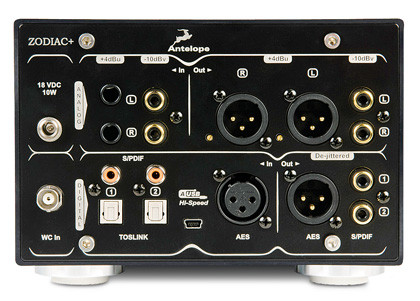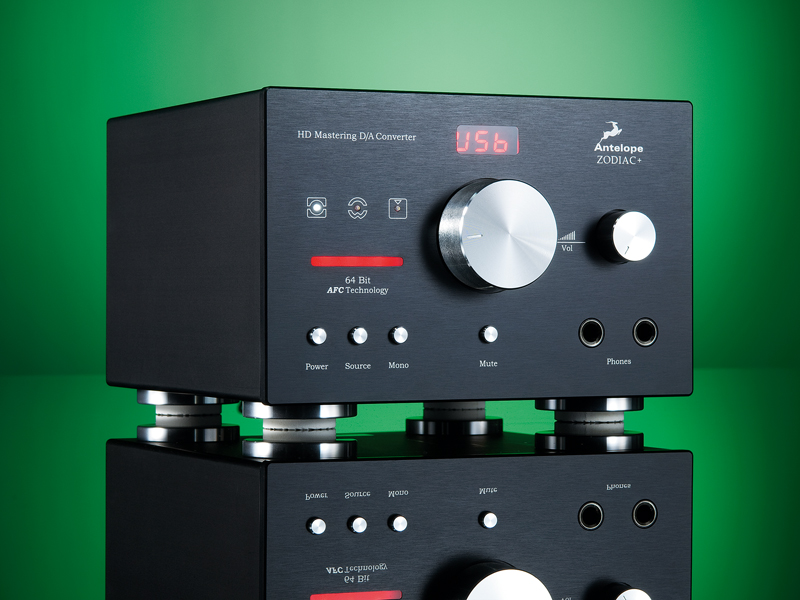TechRadar Verdict
Pros
- +
Remarkable resolving capabilities
- +
More inputs than the majority of DACs
Cons
- -
USB -B socket is a strange choice
- -
A remote handset would be a boon
Why you can trust TechRadar
Antelope Audio is putting Bulgaria on the hi-fi audio map with a new cutting-edge DAC/preamp built for the Pro World. The Zodiac Plus is an innovative compact cube that has digital, analogue and USB inputs, a volume control on the outside and a 24-bit/192kHz convertor inside.
But what separates it from the pack is the company's expertise in digital clocking. Antelope's Pro heritage also shows in the dual headphone sockets on the front panel and the full range of XLR sockets on the back.
Auto-detect
The Zodiac Plus is the middle model of three Zodiac DACs, the base model is due this spring and the Zodiac Gold sits at the top of the tree at £500 more than the Plus.
All three inhabit a squat 110mm-high case, yet each is generously equipped with a well-featured array of rear sockets, including the usual S/PDIF options on coax and optical, as well as XLR sockets for the Pro-grade AES/EBU connection system with inputs and de-jittered outputs.
Analogue outputs are provided in both balanced and single-ended varieties and there are two analogue inputs, one standard RCA phono pair and one called TRS balanced – this is a 6mm jack connection for patch cables in the studio and not one we've seen on domestic audio before.
As already stated, there is also a pair of 6mm headphone jacks on the front panel next to the volume and balance controls – the former is of the analogue variety and so does not have the potential to drop bits in the way that certain digital ones do.
Sign up for breaking news, reviews, opinion, top tech deals, and more.

Input selection is via a single button, which scrolls through the auto-detected inputs whose abbreviated names are shown in the LED. When the Zodiac locks onto the source it displays the sample rate on offer, which is useful if you are using a PC with high bit rate files and want to be sure that the computer is outputting the correct sample rate.
This display also shows output level while the control is being used and briefly thereafter, which is a nice touch.
The only obvious omission is of a remote control for volume and input. You get one of these in machined aluminium with the Zodiac Gold and it would certainly have been handy if a more affordable handset had been included here.
Word clock inputs are pretty scarce in domestic audio, but pretty much the norm in the studio where they are considered pretty fundamental. In our world, only Esoteric and dCS have this feature and their prices are dramatically higher.
The Zodiac Plus has its own onboard clock, a shielded, 'oven controlled' one at that. This means that it's kept at a constant temperature, improving stability and, according to Antelope, brings significant sonic benefits in turn.
The USB will accept signals up to 192kHz, but the use of a mini B socket is slightly odd and limits the array of good-quality USB leads that can be used, one is supplied in the box (albeit rather a long one for best results). Item Audio supplied a high-end alternative from Polestar, but that takes things to the opposite extremes by being unduly short.
Signs of the Zodiac
Whilst the Zodiac is not a big box for the money it clearly doesn't scrimp on socketry and features, things like mute and mono buttons are very handy. Build quality is good, rather than impressive and the case is aluminium, as are the control knobs, both of which are very smooth in operation.
If the sound quality is anything to go by then the money appears to have been spent where it counts, on the circuitry. It has separate power supplies and PCBs for the analogue and digital sections and a Burr- Brown 1792A 24/192 convertor at its heart.
There's no shortage of decent DACs at this price point, but few of them have a volume control, let alone the array of in-and output options.
The convertor that comes closest to the Zodiac Plus in respect of features is the Benchmark DAC1 Pre HDR (£1,595). It also has volume, twin headphone sockets and USB, alongside analogue inputs, but no AES/EBU. The Cyrus DAC XP is more expensive and devoid of USB, but can be very revealing. However, we wouldn't expect it to give the Zodiac too much trouble in a transparent system with a good source.
The real competition comes from more traditional DACs like the Naim DAC, which is only a little more expensive, has two standard USB B sockets and quite significant power supply upgrade options. This is one area where Item Audio feels the Zodiac Plus can be upgraded and it is possible to use the linear supply from the Gold model for the purpose, albeit for a higher combined cost than the Gold itself.
Slow burn
The Zodiac Plus is one of those components that is initially subtle, but which grows in one's estimation every time a familiar track is played and very soon it becomes difficult to go back to the system as was.
It is very low on character and extremely clean in a smooth, rather than crystalline fashion. There are apparently no rough edges across the band, which must be a bonus in the studio, where listening levels are reputedly even higher than in our Hi-Fi Choice listening rooms.
There is a lot to enjoy in its performance. Stereo separation is outstanding – instruments being precisely placed in the lateral stage, which contributes to excellent image depth and solidity. Stevie Wonder's Superstition, for example, reveals unusually distinct reverb effects that we have not previously encountered.
Image quality is particularly apparent when using the Antelope with Bryston's BDP-1 digital transport via its AES/EBU output. This combination pulls out a staggering levels of detail from a number of very familiar tracks – harmonics, reverb and temporal subtleties are brought to the fore that usually remain hidden.
It does this rather better than Bryston's own DAC in truth, which seems a shade unsophisticated by comparison. In part this is because the highs are a lot smoother, but there is plenty of high-frequency detail as well, so there is no sense of roll-off.
With a Mac supplying signal via a Polaris USB lead, the result is considerably more powerful and dynamic than is usually the case – there isn't so much space and air on Rachmaninov's Symphonic Dances, but a heck of a lot of welly.
Bass is also strong point. Orchestra's can produce an awful lot of power in full flight, but this is not often apparent to the extent that it is here. This quality is even more distinct, when you use the onboard volume control and bypass the preamp. Unless you have a particularly good preamp this direct approach is likely to give the best result where dynamics are concerned.
Regular CD via coax from a player (rather than transport) is particularly engaging as well. It is exceptionally coherent and calm under pressure, which means that the heaviest tracks remain open and three dimensional.
Benchmark two
The Zodiac Plus is an exceptionally resolute and entertaining convertor/preamp, that is better equipped than any other DAC we've seen, outside of the megabucks fraternity and even then only MSB's Platinum IV comes close.
The only limitation that we can see is the unusual choice of a mini-USB input, at present there aren't any audio-specific cables for this connection. In all other respects, this unusually well equipped and compact convertor is in another league to most of the similarly priced competition.
If refined resolution of dynamics, timing and image depth are your bag and you can use its preamp potential, then it's a bargain. It is extremely revealing. It's kind to lesser recordings and allows great ones to knock your socks off.
We are intrigued to hear what a dedicated external word clock can do for it, but as it stands it should have the competition quaking.
Follow TechRadar Reviews on Twitter: http://twitter.com/techradarreview
